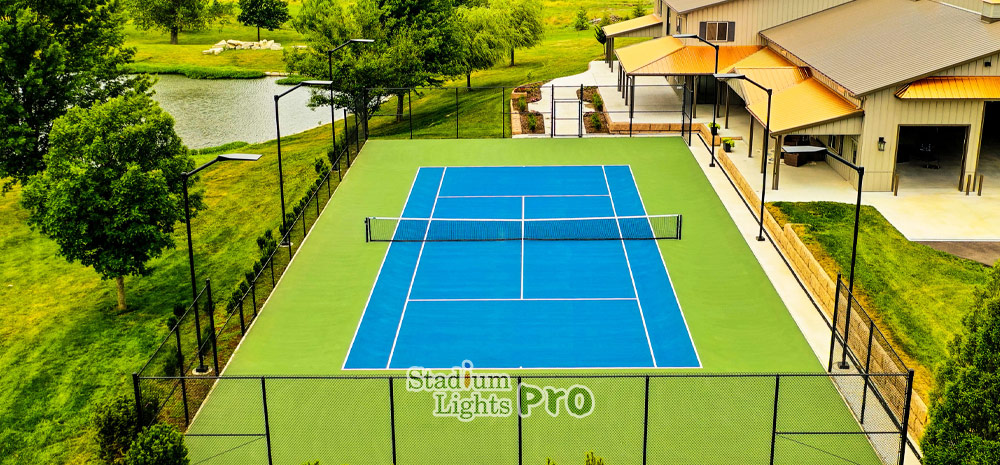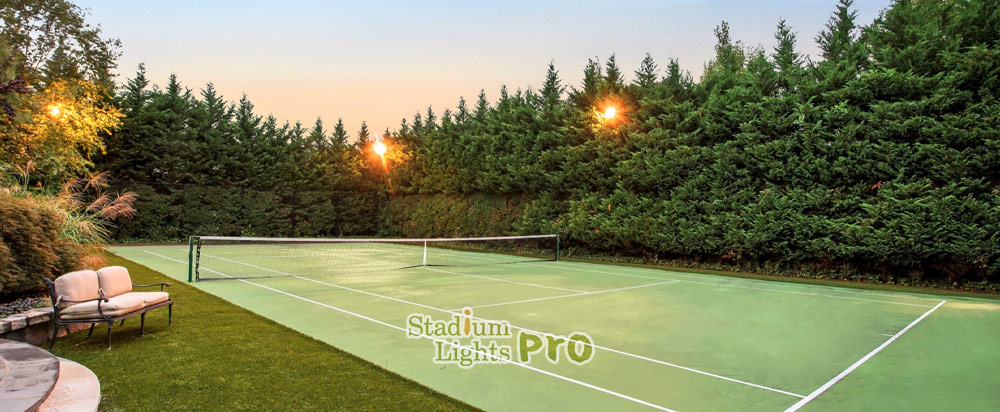Tennis court light pole layout refers to the arrangement and placement of the light poles around a tennis court. The goal of the layout is to provide adequate lighting for play while minimizing shadows on the court and interference with the view of the players and spectators.
There are several common layout patterns for tennis court light poles, including four poles placed at the corners of the court, two poles placed at the center of the baselines, six poles with additional poles at the center of the service lines, and eight poles with additional poles at the center of the service boxes. The optimal layout for a particular tennis court will depend on the size and shape of the court, the height of the poles, and the intensity of the lighting needed.
Table of Contents
ToggleWhat are the common tennis court light pole layout?
There are a few common layout patterns for tennis court light poles. Here are a few examples:
Four poles

If you are using a layout with four poles, the poles should be placed at the corners of the tennis court. This will provide the most even distribution of light and minimize shadows on the court. The poles should be tall enough to allow for sufficient clearance over the playing surface, but not so tall that they interfere with the view of the players or spectators. The intensity of the lighting will depend on the needs of the facility and the intended use of the court.
Two poles

Two poles should be placed at the center of the left and right baselines in a layout with two poles. This layout is not as common as the four-pole layout because it tends to create more shadows on the court. However, it can be a good choice for smaller courts or facilities with limited space. The poles should be tall enough to allow for adequate clearance over the playing surface, but not so tall that they obstruct the view of the players or spectators. The lighting intensity will depend on the needs of the facility and the purpose of the court.
Six poles

In a layout with six poles, the poles should be positioned at the corners of the court and at the center of the service lines. This layout offers more even lighting and fewer shadows on the court than the two-pole layout, but requires more space and may be costlier to install. The poles should be tall enough to allow for sufficient clearance over the playing surface, but not so tall that they obstruct the view of the players or spectators. The lighting intensity will depend on the needs of the facility and the purpose of the court.
Eight poles
For eight poles layout, the poles should be placed at the corners of the tennis court and at the center of the service boxes. This layout provides the most even distribution of light and the fewest shadows on the court, but requires the most space and is the most expensive to install. The poles should be tall enough to provide sufficient clearance over the playing surface, but not so tall that they interfere with the view of the players or spectators. The intensity of the lighting will depend on the needs of the facility and the intended use of the court.
How many lights do we need to light a tennis court?

Determining the number of lights needed to adequately light a tennis court requires considering several factors, including the size and layout of the court, the intensity of the lighting needed, and the height and placement of the light poles.
To begin, it is necessary to know the dimensions of the court. A standard doubles tennis court is 23.77 meters long and 10.97 meters wide, for a total area of 258.5 square meters. However, the lighting needs to cover not just the playing surface, but also the walls and ceiling of the court. The walls of the court are 6.1 meters high, so the surface area of the four walls is (23.77 x 6.1) + (10.97 x 6.1) = 141.87 square meters. The surface area of the ceiling is simply the total area of the court, or 258.5 square meters. Thus, the total surface area to be lit is 141.87 + 258.5 = 400.37 square meters.
Next, we need to determine the intensity of the lighting needed. This will depend on the specific requirements of the facility and the intended use of the court. A commonly used minimum for outdoor tennis courts is 300 lux. Thus, we need a total of 400 square meters x 300 lux = 120,000 lumens of light to adequately light the court.
Finally, we need to determine the number of lights needed to provide this amount of light. This will depend on the output of each individual light. If we assume that each light provides 30,000 lumens, then the number of lights needed is 120,000/ 30,000 = 4 lights.
This is just a rough estimate, and the actual number of lights needed may vary depending on the specific conditions of the court. For example, if the lighting intensity needed is higher or the height of the light poles is greater, more lights may be required. It is always best to consult with a lighting specialist to determine the optimal lighting configuration for your specific needs.
What can go wrong if we use the wrong tennis court light pole layout?
Using the wrong tennis court light pole layout can result in a number of problems. Some potential issues include:
Insufficient lighting
If a tennis court has insufficient lighting, it can be difficult for players to see the ball and play at their best. This can lead to a decrease in the quality of play and an increase in injuries. Players may have difficulty judging the trajectory of the ball and may misjudge shots, leading to mistakes and errors. Poor lighting can also make it more difficult for spectators to follow the action, reducing their enjoyment of the match.
Uneven lighting
If the layout is not properly balanced, it can create shadows and areas of uneven lighting on the court. This can make it difficult for players to judge the trajectory of the ball and can lead to misplays and mistakes.
Interference with the view of the players and spectators
If the light poles are too tall or improperly placed, they can obstruct the view of the players and spectators. This can be especially problematic if the poles are near the back of the court, as they can block the view of balls hit near the back boundary lines.
Increased costs
Using the wrong layout can result in increased costs for lighting installation and maintenance. For example, a layout with more poles may require more wiring and additional lights, resulting in higher installation costs. A layout with poles that are too tall may require specialized mounting equipment, which can also increase costs.
Conclusion
Different layouts will be suitable for different courts and facilities depending on their size, shape, and intended use. Common layouts include four poles at the corners of the court, two poles at the center of the baselines, six poles with additional poles at the center of the service lines, and eight poles with additional poles at the center of the service boxes. Consultation with a lighting specialist can help to determine the optimal layout for a particular court. Insufficient lighting, uneven lighting, and interference with the view of the players and spectators are some potential problems that can arise from using the wrong layout.
Are you in need of a tennis court lighting layout that will provide optimal illumination for your facility? Look no further! Our team of lighting experts can design a layout that takes into account the size and shape of your court, the intensity of the lighting needed, and the height and placement of the light poles. And the best part? Our design service is completely free. Don’t hesitate, contact us today to get started on creating the perfect lighting solution for your tennis court.

